#191: Laetiporus persicinus
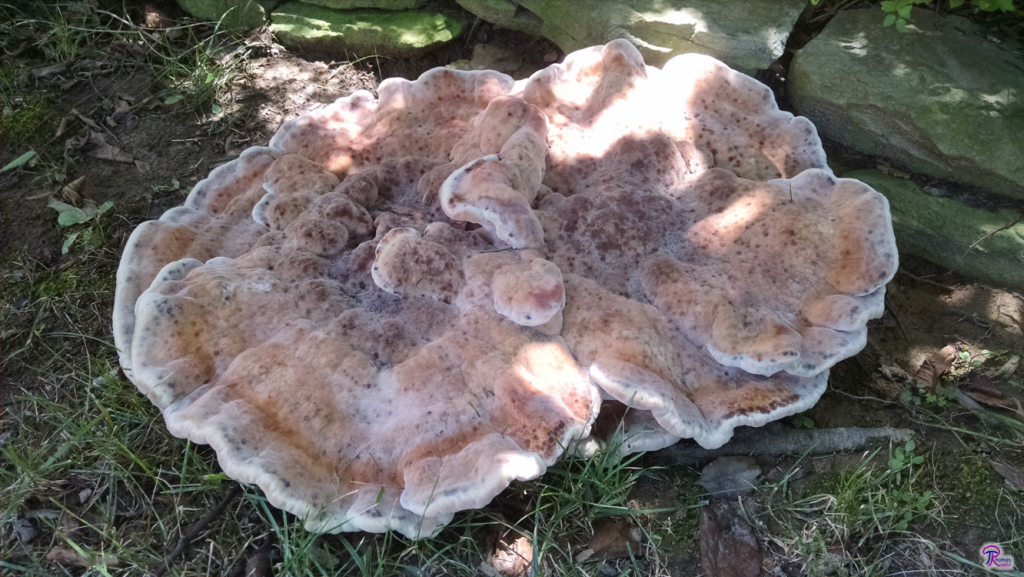
Laetiporus persicinus can grow to extremely large sizes. This specimen was roughly half a meter across!
For some reason, the internet lacks a good description of Laetiporus persicinus. I seek to remedy that in this post. Laetiporus persicinus does not resemble Chicken of the Woods (L. sulphureus and allies, FFF#102), despite the fact that they belong to the same genus. Instead, it is closer in appearance to Inonotus hispidus or Phaeolus schweinitzii. To me, the only part of this mushroom that resembles Chicken of the Woods is the way its surface ripples. Laetiporus persicinus, sometimes called the “White Chicken Mushroom” or “Spring Chicken,”1 is a medium to very large fleshy polypore that grows on dead trees and logs. The surface of the mushroom is light orange-brown with tones of red, white, and purple, while the pores underneath are white and instantly stain dark brown when handled.
Description
L. persicinus produced the largest fruiting body I have ever seen, yet at the time I was unable to identify it. This is primarily because there are no field guides or internet sites that adequately describe the species. When authors describe L. persicinus, it is usually compared to Chicken of the Woods, which is not visually similar. My attempts to identify the mushroom usually ended at P. schweinitzii, which was clearly different. Eventually, I posted it on Mushroom Observer, where it was identified as L. persicinus. Of course, the descriptions available online and in field guides were so dissimilar to my collection that I remained skeptical of that ID until a similar mushroom was found and identified by professional mycologists at the NAMA 2016 Shenandoah foray.
To help make this process easier for my fellow mushroom hunters, I present this detailed description of L. persicinus.
[Read a shortened version of this description here]
Young Mushroom (A Few Days Old)
Most collections of the White Chicken Mushroom are medium-sized roughly circular mushrooms with a central stipe. These typically grow 3-25cm across and 4-9cm tall.1,2 L. persicinus forms a stocky stipe that in young mushrooms may be nearly as large as the pileus. The pileus is flattish, but may form a slight dome in young specimens. At this stage, the pileus begins to form broad radial ripples that slightly distort the otherwise circular margin. The margin is about 1-2cm thick, but thins out somewhat as the mushroom ages.
Young L. persicinus mushrooms feature shades of light pink, light orange, and white.1,2 Colors on the pileus are patchy and often appear in broad concentric rings. When touched, the disturbed areas of the pileus turn brownish but eventually regain their former color. Most of the pileus has a velvety texture at this point. The margin is usually smoother and lighter in color than the rest of the pileus because it marks the transition to the whitish pore surface.
The pore surface coats the underside of the mushroom, extending from near the edge of the pileus to almost the base of the stipe. This surface is white or off-white but instantly bruises dark brown when touched. These stains are lost after a few hours as the pores continue to grow and elongate. All surfaces quickly stain brown and excessive handling of this mushroom can stain your fingers for days. L. persicinus produces small pores; 3-4 widely spaced circular pores fit in each millimeter. The young pores are fairly short, but in mature specimens the pore layer can be up to 1cm thick. Sometimes, the pore surface of young mushrooms exudes droplets of reddish-brown liquid. The characteristics of the pore surface remain constant throughout development of the mushroom.
Middle-Aged Mushroom (About One Week Old)
Things get interesting once the mushroom grows larger than a salad plate. Now, most of the mushroom’s growth happens on the outer margin of the pileus, so the mushroom gets wider but not much taller. The ripples on the pileus become more pronounced and are visually reminiscent of the ripples on the surface of Chicken of the Woods. Near the center of the mushroom, broad bumps develop that quickly obscure the original domed shape of the pileus.
The colors of L. persicinus tend to darken with age. Light orange and pink colors still dominate most of the mushroom, but the central area gradually becomes darker. The center now features shades of reddish-brown and brownish purple. At this stage, the entire pileus is coated with short white hairs. These hairs are actually hyphae growing out to make the mushroom larger. The space between the hairs will get filled in by other hyphae; meanwhile the hairs continue to grow out further. Touching the top of the mushroom presses down these hairs to temporarily reveal the deeper colors of the pileus and also stains the pileus slightly brown.
Mature Mushroom (About 10 Days Old)
Once the mushroom passes the size of a dinner plate, some of the ripples start to form into distinct lobes that overlap slightly. The bumps on the center of the pileus grow up a few centimeters and start making a new pileus with a new pore surface (this behavior is termed ‘adventitious fruiting’). This gives the mushroom a tiered appearance; field guides often call it a ‘rosette’, but that implies the lobes and tiers are much more distinct than they actually are. The lobes usually do not extend in toward the center more than a few centimeters and the center of the mushroom remains a large undifferentiated mass of tissue.
The darker colors become more prominent in the pileus as the mushroom ages, although actively growing areas remain lighter shades of pink and orange. Until the mushroom is completely finished growing, the margin remains as white as the pore surface.
All the tiers become more pronounced as the mushroom reaches serving platter sizes. If the fungus is particularly well nourished, it may produce multiple large fruiting bodies that can fuse laterally to form structures approaching widths of a full meter!
Other Factors
The exact shape of L. persicinus varies depending on the environment in which the mushroom is growing. L. persicinus employs indeterminate growth, so the mushroom may engulf sticks, leaves, and debris as it grows. This also means that it will form semicircular fruiting bodies when growing from the side of a tree or log. Additionally, L. persicinus rots fairly quickly; yeasts and molds often begin decomposing the mushroom before it is done growing. This can result in morphological irregularities as the uninfected areas nearby grow around the rotting areas.
Weather can impact the appearance of L.persicinus on a time scale of minutes to hours. In a rainstorm, all the white hairs on the pileus are quickly pressed down to the surface. This induces some brown staining while at the same time making the darker colors of the pileus visible. When this happens, the entire pileus changes from orange-pink to brown-purple in a few minutes. Once the rain is over, the hyphae on the pileus begin growing again and cover the mushroom with a new crop of white hairs in just a few hours. This process also happens when you touch the mushroom, but in that case the color changes are localized to your handprint.
The interior of the White Chicken Mushroom has a fleshy to spongy texture and very wet; squeezing the flesh quickly produces brownish-red liquid. Older parts of the mushroom take on a corky texture. Even though some field guides report that L. persicinus becomes woody in age,1 my experience is that the mushrooms never last that long. When sliced open, the interior is whitish to light brown in color and features darker growth rings. Exposed surfaces quickly stain brown.
One of the most noticeable characteristics of L. persicinus – after its size and colors – is its odor. Although relatively mild, the odor is musty and unpleasant. Unfortunately, this smell easily sticks to anything that touches the mushroom, so be prepared for your hands to stink if you handle L. persicinus.
L. persicinus produces a white spore print. Under the microscope, the spores are clear, smooth, ovoid to elliptic, and measure 6.5-8µm long and 4-5µm wide.2
Ecology
L. persicinus grows in many parts of the world. In the United States, the White Chicken Mushroom is most common in the southeast. The mushroom is occasionally reported as far north as Maryland and as far west as Texas, although it appears to stay east and south of the Appalachian Mountains. There are also a couple reports from the West Coast, even as far north as the Pacific Northwest.3,4 L. persicinus seems to be most common in North Carolina and Florida and is considered rare in other parts of its range.3–5 Elsewhere, the mushroom also appears in Central America, South America, Africa, Asia, and Australia.6–8
The White Chicken Mushroom is a decomposer of hardwood and conifer wood. Most of the time L. persicinus grows on oaks, but it occasionally appears on pines. The mushrooms usually appear on the ground next to tree stumps, although they sometimes fruit directly from the wood.1,2,9
Mushrooms of L. persicinus appear anytime from late spring to late summer.2 I have found that the fungus prefers growing mushrooms during hot and dry weather. In my area, there is often an early fruiting in June, but rain usually stunts the growth of those mushrooms. The fungus is more successful in late July or early August, where there are often long periods without any rain and the mushrooms last for weeks. Sometimes, there is a third fruiting in late August or September, but by then the fungus has used most of its resources and these late mushrooms are relatively small. Presumably, the season will start earlier in warmer climates and later in cooler ones.
Fruiting in hot and dry weather is unusual for mushrooms, which usually fruit soon after rain to take advantage of moist conditions. L. persicinus’ odd choice of fruiting times appears to be a strategy to make the mushrooms last longer. During rainy spells, the mushrooms are quickly attacked by parasites and quickly decompose to black goo within a few days. In dry weather, the parasites take longer to colonize the mushrooms, allowing the mushrooms to last for weeks. I guess L. persicinus makes up for the lack of water by producing a waterlogged sponge-like mushroom.
Similar Species
Chicken of the Woods is the mushroom most often compared to L. persicinus. I don’t understand this; in my opinion, the two mushrooms have very little in common. Chicken of the Woods is a much brighter and thinner mushroom that forms true rosettes. It would be difficult to mistake these mushrooms, which are bright orange on top and smell pleasant, with those produced by L. persicinus.
As I mentioned earlier, P. schweinitzii was most often the result I got when attempting to key out L. persicinus. P. schweinitzii is very similar in growth habit and habitat, but its pore surface is yellowish to brownish.10 This easily distinguishes it from the white pores of L. persicinus.
Inonotus hispidus is probably the closest look-alike to L. persicinus. However, I. hispidus has a much tougher texture, is more yellow, and usually grows directly from wood.11
Another possible source of confusion is Bondarzewia berkeleyi, which has a similar habitat and size to L. persicinus. B. berkeleyi can be distinguished thanks to its habit of forming true rosettes (even if some of the fronds can extend half the way around), its thinner flesh, and its lack of pink and purple colors. If you’re still unconvinced, take a closer look at the pores: B. berkeleyi has large, irregular, and maze-like pores.12
Edibility
Most field guides this mushroom edible, although there does not seem to be a consensus on edibility.1,2,5,13 Mycologist Bill Russell suggests this mushroom is best when young.1 Personally, I do not find the mushroom very appetizing. Its odor – which does not go away when dried – is too unpleasant for me to consider eating the mushroom. Perhaps very young specimens are less smelly. However, L. persicinus does make good (if a bit pungent) mushroom paper (see FFF#084).
Taxonomy
Currently, L. persicinus belongs to the same genus as Chicken of the Woods. However, DNA analysis shows that the fungus is significantly different from the core Laetiporus species. Actually, L. persicinus appears to be more closely related to P. schweinitzii than to the rest of Laetiporus, so its inclusion in Laetiporus makes that genus polyphyletic. L. persicinus will most likely be assigned to a different genus in the future. Preliminary studies suggest that the species is genetically distinct enough from any other known mushroom to warrant placing it in a new genus by itself.9
| Kingdom | Fungi |
| Division | Basidiomycota |
| Subdivision | Agaricomycotina |
| Class | Agaricomycetes |
| Order | Polyporales |
| Family | Fomitopsidaceae |
| Genus | Laetiporus |
| Species | Laetiporus persicinus (Berk. & M.A. Curtis) Gilb.14 |
This post does not contain enough information to positively identify any mushroom. When collecting for the table, always use a local field guide to identify your mushrooms down to species. If you need a quality, free field guide to North American mushrooms, I recommend Michael Kuo’s MushroomExpert.com. Remember: when in doubt, throw it out!
See Further:
https://en.wikipedia.org/wiki/Laetiporus_persicinus
http://blog.crazyaboutmushrooms.com/chicken-woods-mushrooms-primer-laetiporus/
https://www.nrs.fs.fed.us/pubs/jrnl/2008/nrs_2008_lindner_001.pdf
Citations
- Russell, B. Field Guide to Wild Mushrooms of Pennsylvania and the Mid-Atlantic. (Penn State Press, 2006).
- Bessette, A., Bessette, A. R. & Fischer, D. W. Mushrooms of Northeastern North America. (Syracuse University Press, 1997).
- Occurrence Map for Laetiporus persicinus (Berk. & M.A. Curtis) Gilb. Mushroom Observer Available at: http://mushroomobserver.org/name/map/2791. (Accessed: 16th June 2017)
- Laetiporus persicinus. Mycology Collections Portal Available at: http://mycoportal.org/portal/taxa/index.php?taxon=184812. (Accessed: 15th June 2017)
- McHugh, A. A Birdseye View of Chicken of the Woods (Pun Intended). Crazy About Mushrooms Blog (2015).
- Laetiporus persicinus. Wikipedia (2016).
- Laetiporus persicinus (Berk. & M.A. Curtis) Gilb. Smithsonian Tropical Research Institute Available at: http://biogeodb.stri.si.edu/fungi/en/species/1863/. (Accessed: 15th June 2017)
- Laetiporus persicinus (Berk. & M.A.Curtis) Gilbertson, Mycotaxon 12: 385 (1981). Royal Botanic Gardens Melbourne Available at: http://data.rbg.vic.gov.au/cat/fungicatalogue/name/8769. (Accessed: 15th June 2017)
- Lindner, D. L. & Banik, M. T. Molecular phylogeny of Laetiporus and other brown rot polypore genera in North America. Mycologia 100, 417–430 (2008).
- Kuo, M. Phaeolus schweinitzii. MushroomExpert.Com (2016). Available at: http://www.mushroomexpert.com/phaeolus_schweinitzii.html. (Accessed: 16th June 2017)
- O’Reilly, P. Inonotus hispidus (Bull.) P. Karst. – Shaggy Bracket. First Nature Available at: http://www.first-nature.com/fungi/inonotus-hispidus.php. (Accessed: 16th June 2017)
- Emberger, G. Bondarzewia berkeleyi. Fungi Growing on Wood (2008). Available at: http://www.messiah.edu/oakes//fungi_on_wood/poroid%20fungi/species%20pages/Bondarzewia%20berkeleyi.htm. (Accessed: 16th June 2017)
- Miller, O. K. & Miller, H. North American mushrooms: a field guide to edible and inedible fungi. (Falcon Guide, 2006).
- Laetiporus persicinus. Mycobank Available at: http://www.mycobank.org/Biolomics.aspx?Table=Mycobank&Rec=44920&Fields=All. (Accessed: 15th June 2017)
(full text of Linder & Banik, 2008: https://www.nrs.fs.fed.us/pubs/jrnl/2008/nrs_2008_lindner_001.pdf)

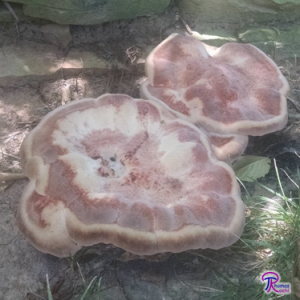
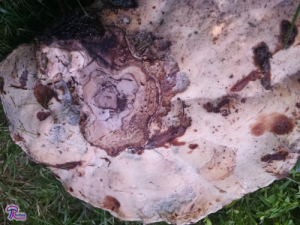
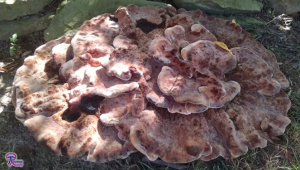
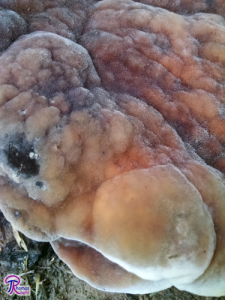
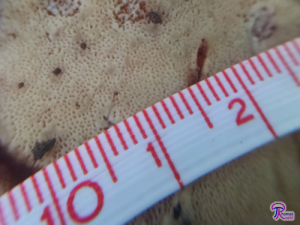
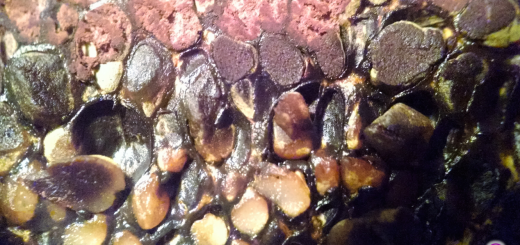
![#057: The Witch’s Hat, Hygrocybe conica [Archived]](https://www.fungusfactfriday.com/wp-content/themes/hueman/assets/front/img/thumb-medium-empty.png)
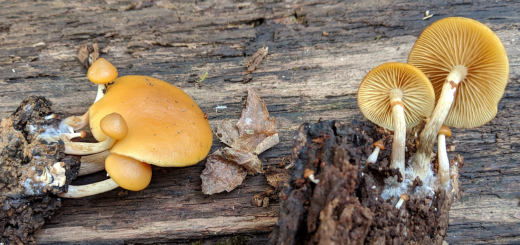





![#011: Characteristics of Kingdom Fungi [Archived]](https://www.fungusfactfriday.com/wp-content/themes/hueman/assets/front/img/thumb-small-empty.png)

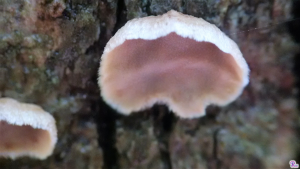
Finally, a comprehensive description of L. persicinus! Well-written!
Thank you for this post. I have 3 of these growing in my front yard now. They are from 8″ to 15″ in diameter.. I had a couple last year but did not know what they were.
Could be confused with Ischnoderma benzoinum and I. resinosum. Thanks for sharing all that work!